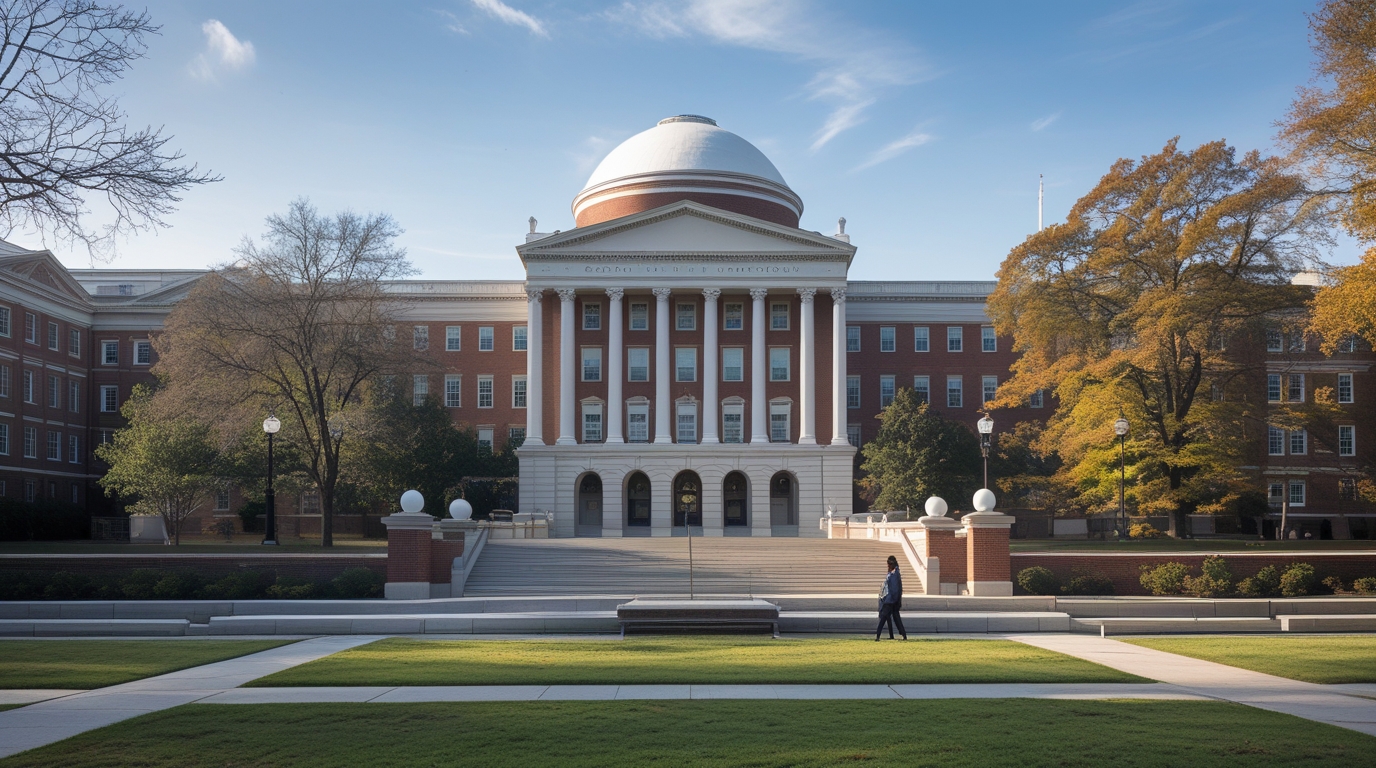
George Washington University Acceptance Rate
Introduction: Unlocking the Doors to George Washington University
Nestled in the heart of Washington, D.C., George Washington University stands as a beacon for ambitious students drawn to the pulse of politics, policy, and global affairs. Founded in 1821, GWU has evolved into a dynamic private research university where future leaders immerse themselves in real-world opportunities right outside their classroom doors.
With its urban campus spanning Foggy Bottom and Mount Vernon, the university offers a blend of academic rigor and unparalleled access to internships at the White House, Capitol Hill, and international organizations.
The George Washington University acceptance rate reflects its growing selectivity, making it a sought-after choice for undergraduates aiming to blend scholarly pursuits with practical experience.
As application volumes rise each year, understanding this rate alongside admissions trends can guide prospective students in crafting compelling applications. This article delves into the latest data, historical context, and insider tips to help you navigate the process effectively.
The Current George Washington University Acceptance Rate: What the Numbers Say
For the Class of 2028, the George Washington University acceptance rate settled at 43.5 percent, based on 27,094 applications resulting in 11,798 offers of admission. This figure marks a slight dip from the previous year’s 49 percent, signaling GWU’s intentional push toward greater selectivity to align with peer institutions like Boston University.
While exact figures for the Class of 2029 remain forthcoming as of September 2025, early indicators suggest continued competition, with application numbers holding steady around 27,000.
This rate positions GWU as moderately selective among national universities, far more accessible than ultra-competitive peers like Georgetown at 12 percent but demanding a strong academic profile nonetheless.
Admissions officials emphasize a holistic review, where the George Washington University acceptance rate isn’t just a statistic but a reflection of diverse talents from across the globe. Yield rates, hovering near 25 percent, also play a role, as the university calibrates offers to fill its incoming class of about 2,800 freshmen.
Historical fluctuations in the George Washington University acceptance rate offer context for current applicants. In 2021, amid pandemic-driven test-optional policies, the rate climbed to 49.7 percent before edging down, illustrating how external factors influence selectivity.
As GWU refines its enrollment strategies, prospective students should view this metric as a benchmark rather than a barrier, focusing on standout elements in their profiles.
Historical Trends in GWU Admissions Selectivity
Over the past decade, the George Washington University acceptance rate has trended downward from highs near 50 percent in the early 2010s to the mid-40s today, mirroring a broader surge in applications to urban research universities.
This shift coincides with GWU’s enhanced reputation in fields like international affairs and public health, drawing record interest from high-achieving applicants nationwide and abroad. By 2023, applications exceeded 27,000 for the first time, pressuring the rate to 43 percent and underscoring the university’s rising prestige.
Key milestones highlight this evolution: the 2020 cycle saw a temporary spike to 43 percent due to disrupted testing, but post-pandemic recovery brought it back to 49 percent in 2022 before the recent decline.
These trends in the George Washington University acceptance rate are driven by strategic enrollment management, including targeted recruitment in STEM and policy programs. For the Class of 2029, experts anticipate stability around 43-45 percent, barring major shifts in applicant pools influenced by economic or global events.
Understanding these patterns empowers applicants to contextualize their odds within GWU admissions statistics. While the rate has become more competitive, enrollment has grown modestly to 11,677 undergraduates in fall 2024, allowing space for qualified candidates who demonstrate fit with the university’s mission.
Historical data from GWU’s Common Data Set reveals consistent yield improvements, suggesting that admitted students increasingly view the school as their top choice.
Breaking Down the Applicant Pool and Demographics
The George Washington University acceptance rate varies subtly by applicant type, with early decision rounds offering a notable edge over regular decision. For the Class of 2028, early decision acceptance reached 66 percent among 1,139 applicants, compared to the overall 43.5 percent, as binding commitments help secure high-yield talent. Regular decision, comprising the bulk of applications, aligns closely with the total rate, emphasizing the value of early action for committed candidates.
Demographically, GWU’s incoming classes reflect a diverse tapestry that influences the George Washington University acceptance rate calculations. In recent years, 40 percent of enrollees hailed from the top 10 percent of their high school classes, with 73 percent in the top quartile, per admissions profiles.
Racial and ethnic diversity has strengthened, with Asian American students at 12.7 percent, Black or African American at 10.3 percent, and Hispanic or Latino at 10.1 percent of the total undergraduate body in 2023.
Geographic spread adds another layer, with 44.3 percent White students dominating but international representation from over 130 countries enriching the mix. The George Washington University acceptance rate benefits from this broad appeal, as admissions prioritize underrepresented voices in policy and global studies.
For the Class of 2029, expect continued emphasis on first-generation and low-income students, who comprised 16-18 percent in prior cycles, fostering an inclusive environment amid D.C.’s vibrant cultural landscape.
Academic Benchmarks for Admitted Students
Prospective students eyeing the George Washington University acceptance rate should align their profiles with the middle 50 percent ranges of admitted peers. For the Class of 2028, unweighted GPAs averaged 3.96, underscoring the need for near-perfect academic records in rigorous curricula. Course loads heavy in AP, IB, or honors classes signal readiness for GWU’s demanding programs in political science and engineering.
Standardized testing, though optional since 2020, remains a differentiator for many; 30 percent of enrollees submitted scores, with SAT middles at 1360-1470 and ACT at 30-33. The George Washington University acceptance rate for test-submitters hovers slightly higher, as strong results contextualize potential in a holistic review.
Admissions data shows that without scores, essays and recommendations carry extra weight, particularly for applicants from varied educational backgrounds.
Beyond numbers, extracurricular depth matters: leadership in debate clubs, Model UN, or community service aligns with GWU’s ethos. The George Washington University acceptance rate rewards such engagement, as 58 percent of students report feeling individually evaluated in surveys.
For Class of 2029 hopefuls, maintaining a balanced transcript while pursuing passions will position you favorably against a pool where academic excellence meets purposeful involvement.
Strategies to Strengthen Your GWU Application
To navigate the George Washington University acceptance rate effectively, start with a tailored application that showcases your connection to D.C.’s opportunities. The Common App serves as the gateway, supplemented by GWU’s optional 500-word essay—choose prompts on interacting with leaders or personal growth through challenges to reveal your voice authentically. Admissions committees seek narratives that echo the university’s commitment to public service and innovation.
Building demonstrated interest amplifies your case; virtual info sessions, campus tours, or emailing officers about specific programs like the Elliott School of International Affairs demonstrate enthusiasm.
The George Washington University acceptance rate favors engaged applicants, with 53 percent noting a caring process in feedback. Secure glowing recommendations from teachers who can attest to your intellectual curiosity and collaborative spirit.
Financial aid considerations tie into the equation, as 42 percent of first-years receive need-based support, averaging a net price of $34,462 after grants. The George Washington University acceptance rate doesn’t differ by aid status, but transparent CSS Profile submissions ensure equitable access. For Class of 2029 applicants, layering these elements—academics, essays, interest—creates a cohesive portrait that stands out in a competitive field.
Early Decision vs. Regular Decision: Weighing Your Options
Early decision at GWU presents a strategic lever against the George Washington University acceptance rate, with binding agreements yielding that 66 percent success for Class of 2028.
Deadlines fall on November 1 for ED I and January 5 for ED II, ideal for those certain of GWU as their top pick. This path not only boosts odds but signals unwavering commitment, appealing to a university valuing loyalty in its Revolutionaries community.
Regular decision, closing January 5, offers flexibility for comparing offers but aligns with the baseline 43.5 percent rate. The George Washington University acceptance rate in RD draws from a larger pool, where standout supplements become crucial. Data shows ED enrollees often report higher satisfaction, citing the certainty of joining D.C.’s network sooner.
Choosing between them hinges on fit: ED suits passionate applicants ready for GWU’s urban intensity, while RD allows broader exploration. Regardless, the George Washington University acceptance rate underscores timely, thoughtful preparation—whether committing early or polishing a late application to shine.
Transfer and International Admissions Insights
Transfers to GWU enjoy a robust pathway, with a 61.87 percent acceptance rate for 2024, admitting 1,471 from 2,377 applicants. This higher threshold reflects space in upperclass years, particularly for community college credits aligning with majors in business or nursing.
The George Washington University acceptance rate for transfers emphasizes seamless academic transitions, requiring mid-term grades and a clear rationale for switching to Foggy Bottom.
International students face the standard undergraduate rate but must navigate added layers like TOEFL/IELTS scores (minimum 80/100 or 6.0/6.5) and financial certification. Comprising 12 percent of recent classes, they enrich GWU’s global dialogue, with the George Washington University acceptance rate holding steady across borders. Visa support and cultural integration programs ease the journey for those from 29+ countries.
Both groups benefit from holistic scrutiny, where prior achievements and future goals outweigh raw metrics. The George Washington University acceptance rate for these cohorts highlights inclusivity, inviting transfers and globals to contribute to D.C.-centric learning.
Life After Acceptance: Enrollment and Campus Experience
Once past the George Washington University acceptance rate hurdle, enrollees join a vibrant class of 2,800 freshmen, housed in modern residences overlooking the National Mall.
Orientation immerses them in D.C.’s rhythm, from Metro navigation to networking mixers with alumni in federal agencies. With 85 percent graduation rates, GWU supports persistence through advising and peer mentoring.
Career outcomes shine: six years post-grad, median salaries hit $71,607, bolstered by 90 percent placement in fields like government and consulting. The George Washington University acceptance rate filters for driven individuals who thrive in this ecosystem, where internships often lead to full-time roles. Class of 2029 members can anticipate tailored pathways, from research grants to study abroad in 50+ destinations.
Balancing academics with Foggy Bottom’s energy defines the experience—think late-night study sessions amid cherry blossoms or protests turned teachable moments. The George Washington University acceptance rate ensures a cohort primed for such engagement, fostering lifelong connections in the nation’s capital.
The Waitlist: A Second Chance at GWU
Waitlist dynamics add nuance to the George Washington University acceptance rate, with 18.23 percent of 6,517 Class of 2028 candidates ultimately admitted—a jump from prior years’ under 6 percent. This variability stems from yield fluctuations, offering hope for persistent applicants via letters of continued interest. Focus on updates like awards or reflections on GWU fit, submitted promptly by May.
Historically, the George Washington University acceptance rate from waitlists spikes in uncertain cycles, like 2020’s 50 percent amid COVID. For Class of 2029, staying responsive to portal notifications maximizes chances. Admissions views waitlisters as viable fits, rewarding those who reiterate enthusiasm without new applications.
Navigating this requires patience and polish; many off the list credit concise, genuine LOCIs. The George Washington University acceptance rate, while selective, leaves room for such redemptions, turning potential deferrals into celebrated arrivals.
Why GWU’s Selectivity Matters for Future Leaders
The George Washington University acceptance rate encapsulates more than numbers—it’s a gateway to transformative education where proximity to power shapes careers. With rankings at #59 nationally and #47 in selectivity per U.S. News, GWU attracts visionaries eager for impact. This metric evolves with institutional goals, prioritizing diversity and excellence in equal measure.
Applicants should embrace it as motivation, not intimidation, by highlighting unique contributions to GWU’s tapestry. The George Washington University acceptance rate forges a community of 11,677 undergraduates ready to lead, from policy think tanks to tech startups. As D.C. beckons, those who align passion with preparation find their place among the Revolutionaries.
In summary, while the George Washington University acceptance rate hovers competitively, strategic applications unlock its doors. From essays weaving personal stories to activities echoing public service, every element counts toward joining this elite cadre. For Class of 2029 dreamers, the journey starts now—craft boldly, engage deeply, and step into the capital’s spotlight.

